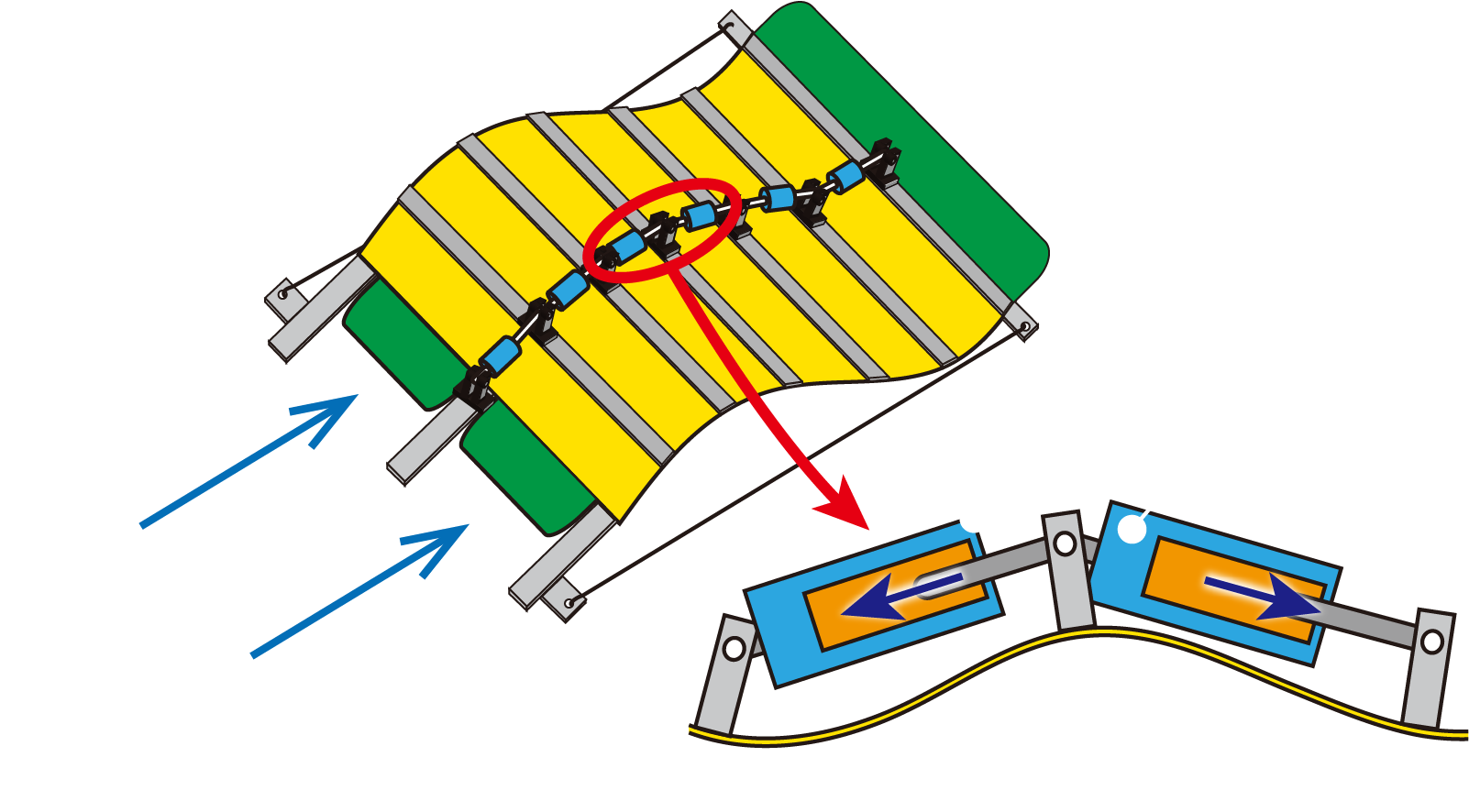Tidal stream generator
潮流発電機
世界第6位排他的経済水域を有する日本にとって、海洋は有益な資源です。 海に囲まれた我が国において潮流は身近な自然現象であり、それをエネルギー資源として利用する潮流発電は我が国の環境に適した再生可能エネルギー利用と言えます。 潮流発電で十分な電力を得るためには、2〜5m/s程度の速い流速が必要とされていますが、そうした海域は日本でも限られます。 また、潮流を受け止めて回転するタービン翼は魚や海藻などを巻き込む懸念から、水産に関わる方々の受けが良くありません。 我々は、フランスのベンチャー企業であるEEL Energy社で発明され、彼らが"Biomimetic"と呼ぶ、アンジュレータ型潮流発電によって、こうした課題を解決できると考えています。 これは、魚の持つひれから発案された技術で、海水を受け止めた膜(メンブレン)が潮流によってうねらせることで電力を生み出します。 回転機とタービン翼を使わないこの手法は、海洋生物を巻き込む怖れが無いばかりか、ベッツの法則で示された理論限界である59.3%を上回る発電効率を実現できる可能性があります。 なにより、アンジュレータ型潮流発電では0.4〜2m/s程度の流速で発電できることから、発電のための海域を比較的自由に選ぶことが可能です。 我々は、小形のアンジュレータ型潮流発電機を我が国の海岸に設置することで、普段は公共施設の補助電源としてエネルギーミックスに利用すると共に、災害時に電力供給の絶たれやすい離島を含む海岸域の非常用電源として利用できると考えて、このアンジュレータ型潮流発電機の研究開発を行っています。
For Japan, which has the world's sixth largest exclusive economic zone, the ocean is a valuable resource.
Surrounded by the sea, the ebb and flow of the tide is a familiar natural phenomenon in Japan. Therefore, tidal power generation, which uses the ebb and flow of the tide as a source of energy, can be said to be one of the renewable energies that is suited to the environment of Japan.
We believe that tidal power generation is suitable for next-generation marine energy generation after offshore wind power generation, and we are advancing research and development of tidal power generators.
In order to obtain sufficient power from tidal power generation, a fast current speed of around 2 to 5 m/s is required, but such areas are limited even in Japan.
In addition, the turbine blades that rotate in response to the current are not well received by those involved in the fishing industry, as there is a concern that they may catch fish and seaweed.
We think that these issues can be solved by the undulator-type tidal power generation invented by the French venture company EEL Energy, which they call "Biomimetic".
This technology was inspired by fish fins, and it generates electricity by causing the membrane that receives seawater to undulate with the flow of water.
This method, which does not use a rotor or turbine blades, not only eliminates the risk of entangling marine life, but also has the potential to achieve a power generation efficiency that exceeds the theoretical limit of 59.3% indicated by Betz's law.
Above all, since undulator-type tidal stream generation can generate power at flow speeds of around 0.4 to 2 m/s, it is possible to choose the sea area for power generation relatively freely.
We are conducting research and development on an undulator-type tidal stream generator with the idea that, by installing small undulator-type tidal stream generators along the coast of Japan, they can be used as an energy mix to provide supplementary power for public facilities during normal times, and as an emergency power source for coastal areas, including remote islands, where power supply is easily cut off during disasters.
 アンジュレータ型潮流発電機の本体は、潮流を受け止めてうねるメンブレンとリニア発電モジュールから構成されます。
複数のリニア発電モジュールはメンブレンに固定され、各々のロッドがメンブレンの動きによって押し引きされることで電力を生み出します。
現在、様々な発電の多くでは回転機が使われており、リニア機を使用することはほとんどありません。
そのためか、リニア発電モジュールの製品は市場にほとんど出回っておらず、アクチュエータ(駆動モータ)の転用、あるいは、製品を特注する必要があります。
そこで我々はアンジュレータ型潮流発電に適したリニア発電モジュールの研究開発を行っています。
アンジュレータ型潮流発電機の本体は、潮流を受け止めてうねるメンブレンとリニア発電モジュールから構成されます。
複数のリニア発電モジュールはメンブレンに固定され、各々のロッドがメンブレンの動きによって押し引きされることで電力を生み出します。
現在、様々な発電の多くでは回転機が使われており、リニア機を使用することはほとんどありません。
そのためか、リニア発電モジュールの製品は市場にほとんど出回っておらず、アクチュエータ(駆動モータ)の転用、あるいは、製品を特注する必要があります。
そこで我々はアンジュレータ型潮流発電に適したリニア発電モジュールの研究開発を行っています。
 The main body of the undulator-type tidal stream generator consists of a membrane that catches the tidal stream and undulates, and a linear power generation module.
Multiple linear power generation modules are fixed to the membrane, and each rod is pushed and pulled by the movement of the membrane to generate electricity.
At present, rotating machines are used in many different power generation systems, and linear machines are rarely used.
Perhaps for this reason, linear generator modules are rarely available on the market, and it is necessary to convert actuators (drive motors) or order products especially.
For this reason, we are conducting research and development on linear power generation modules that are suitable for undulator-type tidal stream generation.
The main body of the undulator-type tidal stream generator consists of a membrane that catches the tidal stream and undulates, and a linear power generation module.
Multiple linear power generation modules are fixed to the membrane, and each rod is pushed and pulled by the movement of the membrane to generate electricity.
At present, rotating machines are used in many different power generation systems, and linear machines are rarely used.
Perhaps for this reason, linear generator modules are rarely available on the market, and it is necessary to convert actuators (drive motors) or order products especially.
For this reason, we are conducting research and development on linear power generation modules that are suitable for undulator-type tidal stream generation.
 メンブレンの周期的なうねりから加わる力はリニア発電モジュールのロッドを押し引きします。
それによって、リニア発電モジュールの中に組み込まれた界磁子の発する磁界の中を電機子が行き来して、電力を生み出します。
この仕組みの問題は、ロッドの駆動方向が逆転する際に動きがいったん停止することと、ロッドの駆動距離が短いことにあります。
前者は停止前にロッドの駆動速度を落とす必要があり、後者と合わせて発電量の減少につながります。
加えて、メンブレンのうねる周期が長いので、発電周波数は小さく、発電出力は大幅に減少します。
従って、アンジュレータ型潮流発電の実用化には、低い周波数・短い駆動距離にも関わらず、大電力の発生を可能にするような、従来に無い新しい仕組みの発電機構が必要となります。
そこで我々は、ハルバッハ配列を改良した構造を持つ界磁子や、鉄芯入りの渦巻型電機子コイルを新たに発案し、これらを組み込んだ新型のリニア発電モジュールの開発を行っています。
メンブレンの周期的なうねりから加わる力はリニア発電モジュールのロッドを押し引きします。
それによって、リニア発電モジュールの中に組み込まれた界磁子の発する磁界の中を電機子が行き来して、電力を生み出します。
この仕組みの問題は、ロッドの駆動方向が逆転する際に動きがいったん停止することと、ロッドの駆動距離が短いことにあります。
前者は停止前にロッドの駆動速度を落とす必要があり、後者と合わせて発電量の減少につながります。
加えて、メンブレンのうねる周期が長いので、発電周波数は小さく、発電出力は大幅に減少します。
従って、アンジュレータ型潮流発電の実用化には、低い周波数・短い駆動距離にも関わらず、大電力の発生を可能にするような、従来に無い新しい仕組みの発電機構が必要となります。
そこで我々は、ハルバッハ配列を改良した構造を持つ界磁子や、鉄芯入りの渦巻型電機子コイルを新たに発案し、これらを組み込んだ新型のリニア発電モジュールの開発を行っています。
 The force exerted by the periodic undulation of the membrane pushes and pulls the rods of the linear power generation module.
The armature moves back and forth in the magnetic field emitted by the field magnet built into the linear generator module, thereby generating electricity.
The problem with this mechanism is that the movement stops when the direction of the rod drive is reversed, and the distance the rod drives is short.
The former requires the driving speed of the rod to be reduced before stopping, and together with the latter, this leads to a decrease in the amount of electricity generated.
In addition, because the period of the undulation of the membrane is long, the frequency of power generation is small, and the power generation output is greatly reduced.
Therefore, in order to make undulator-type tidal power generation practical, a new power generation mechanism that is not seen in conventional systems and that can generate large amounts of power despite the low frequency and short driving distance is required.
We have therefore come up with a new design for a field magnet with an improved Halbach array structure and a new design for a wound armature coil with an iron core, and we are currently developing a new type of linear generator module incorporating these designs.
The force exerted by the periodic undulation of the membrane pushes and pulls the rods of the linear power generation module.
The armature moves back and forth in the magnetic field emitted by the field magnet built into the linear generator module, thereby generating electricity.
The problem with this mechanism is that the movement stops when the direction of the rod drive is reversed, and the distance the rod drives is short.
The former requires the driving speed of the rod to be reduced before stopping, and together with the latter, this leads to a decrease in the amount of electricity generated.
In addition, because the period of the undulation of the membrane is long, the frequency of power generation is small, and the power generation output is greatly reduced.
Therefore, in order to make undulator-type tidal power generation practical, a new power generation mechanism that is not seen in conventional systems and that can generate large amounts of power despite the low frequency and short driving distance is required.
We have therefore come up with a new design for a field magnet with an improved Halbach array structure and a new design for a wound armature coil with an iron core, and we are currently developing a new type of linear generator module incorporating these designs.